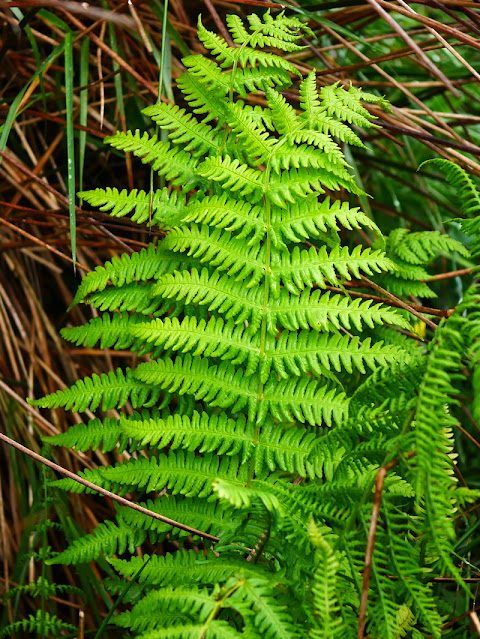The weather pattern throughout July was of numerous low pressure systems bringing wind and rain, not only for Cornwall, but for all of the UK. It seems we might have had our summer in May to June. This is all good for the plants though, especially annuals that will germinate and grow quite late in the season when conditions are right.
Here follows a selection of the wonderful wild plants of Cornwall that I have found on my travels around the county through the middle part of this month.
Starting off in North Cornwall near Bude and I found this Curled Pondweed in a stream close to where it entered the sea. It's a very easily identified plant and I've not seen much else like it. The stems and leaves are quite stiff and do not fold flat when you take them out of the water.
Potamogeton crispus
A surprise find below, was of Smith's Pepperwort, an uncommon and usually coastal plant. I found several plants in the National Trust car park at Sandymouth Bay which were new records for the monad. Unlike Field Pepperwort, the seeds on this plant have the remains of the style poking out of the top of the seed for several millimetres. The plant can grow to about two feet or so tall.
Lepidium heterophyllum
I have never knowingly seen Sea Storksbill before, but I must have walked past it countless times. The leaves look similar to Common Storksbill, but not as finely cut, but if you look very closely, you will see the plants below have green flowers with no petals at all. I found these on a sandy road verge in short turf near the sea.
Erodium maritimum
I do my best to identify grasses when I have the time to study a sample at home. The one below turned out to be a very large Marsh Foxtail growing at the top of a beach in a pool from a stream, dammed by the sea piling up shingle in front of it.
Alopecurus geniculatus
By a cafe on a beach were some nice looking False Fox Sedges. They have a similar structure and look to them as Star Sedge (Carex echinata) but the former are much larger and sturdier with sharply 3 angled stems and downward pointing bracts below the spikelets.
Carex otrubae
Below was an example of an annual species that is usually gone over by late Spring, Thyme-leaved Sandwort. Here it is flowering again on a clifftop in short turf, thanks to plenty of rain! These can be distinguished from Slender Sandwort by their conical "flask" shaped seedpods. Slender has much smaller and straighter pods and much finer leaves too.
Arenaria serpyllifolia s.s.
Plenty of Speedwells are having a second go at flowering too. The following two photos show the very common larger flower of Common Field Speedwell (Veronica persica) compared to two small native annuals I found growing with it - Wall and Grey Field Speedwells.
Veronica arvensis (the tiny flower)
Veronica polita (the smaller flower)
Back inland and I'm looking around the perimeter of a new housing estate and I find Corncockles on a roundabout! They were clearly sown with the amenity planting, but whether they were part of the mix or a contaminant, I don't know. There were no other typical seed mix plants on it.
Agrostemma githago
On a steep bank of disturbed soil by this new estate, I also found a few Field Woundwort plants, likely buried in the seedbank and brought to the surface by earthworks.
Stachys arvensis
Not far away was a huge area comprised of china clay waste with some footpaths through it. On some short turf I found a patch of Chamomile in flower. Easily told apart from other Mayweed type of flowers by its lovely smell when any part is crushed. This is not uncommon in Cornwall, especially on Bodmin Moor, but I'd not seen it in china waste areas before, so it was a nice find. They rarely grow more than 6" tall here.
Chamaemelum nobile
Another nice find on the waste area were numerous Small Cudweed plants, these are small, grey, hoary looking plants with small capitulas comprised of a few uninteresting brown flowers. These are quite rare and declining nationally.
On another local walk, I passed a fenced off area that used to be an arable field but was awaiting being built on for new housing. I spotted the plants below through an impenetrable security fence, so I couldn't get any closer. Other botanists identified them for me as Narrow-leaf Clover, a non-native Clover and no doubt a crop relict. Unfortunately, I won't see it in flower next year as the bulldozers have now moved in.
I took an evening trip to Bodmin Moor as it's only a few miles away from me. In a bog I came across lots of small rush like plants that appeared to be sprouting seeds whilst still on the stalk. I'd not seen this before (bogs being rather scarce in Kent) and the VCR told me this was Bulbous Rush which commonly propogates in this fashion. There's always something new to learn in botany!
I didn't want to leave out ferns on this blog, so here's my first Lemon-scented Fern that I have not been shown by someone else! Since Covid, I have had difficulty smelling much of anything, but this fern really did have the scent of lemons and even I could smell it. What's more, when running my fingers over the back of the fronds it was sticky and felt like Sticky Groundsel to the touch, quite unique I think. You can see the lemon scent glands on the second photo below.































No comments:
Post a Comment
All comments are moderated before publication, so please don't bother spamming me, thank you. Genuine comments most welcome.